If a large luxury limousine is a sign you’ve arrived in life, one with a green number plate is a sign that you’ve arrived with an eco-conscience. Assembled here are two of the finest options available to you. The i7 is BMW’s grandest EV, while the EQS sits at the very top of Merc’s ever-expanding electric sedan line-up.
And while the S and the 7 have traditionally squared off toe to toe, these ones are built to different philosophies and appeal for different reasons.
BMW i7 vs Mercedes Benz EQS: design
The differences between the two start even before we get inside. The two are large electric limousines but take very different approaches to design and styling. And that’s partly down to what lies under the skin. You see, the i7 is based on the same platform as the 7 Series and hence shares the same hardpoints, and resultantly, has the more conventional sedan silhouette. But it’s clearly no understated limo. The split headlamps, the oversized kidney grille that even glows at night and the contrast theme on the bumpers really announce your arrival. Love it or hate it, you can’t ignore it.
 While the i7 is all about rad details, the EQS stands out for its shape.
While the i7 is all about rad details, the EQS stands out for its shape.
The EQS isn’t an electric S-Class. Rather, it’s built on an EV-only platform and uses the design flexibility such an arrangement allows to the fullest. The short bonnet and cab-forward stance quickly establish the EQS as something very different, and the slippery shape also grants the big Merc among the best aero figures for any production car. The organic elements, star-spangled front panel and light bars only up the style quotient.
BMW i7 vs Mercedes Benz EQS: interior
Powered doors are your futuristic entry point to the i7, but inside, it’s the BMW that ticks more of the conventional limousine check boxes. For starters, it’s got the better rear seats. The seats are larger and softer cushioned, offer soothing massages, and there’s a greater degree of backrest recline too. And then there’s the executive package that brings in full-seat extension for the boss seat. When pressed into action, the feature will raise a fold-out legrest, recline the backrest and whirr the front passenger seat forward for max legroom. It’s a fantastic way to travel. All seat controls are via the 5.5-inch screen on the door pads and then there’s the other screen – a 31.3-inch 8K screen that folds out from the roof. The screen runs FireTV and can also hook up your devices via an HDMI port. Sound is channelled through an 18-speaker Bowers & Wilkin system that includes speakers in the headrests. It’s literally your living room on the move, though everyone will not readily take to such a large screen in their face. Irritatingly, the screen also blocks the driver’s view from the mirror.
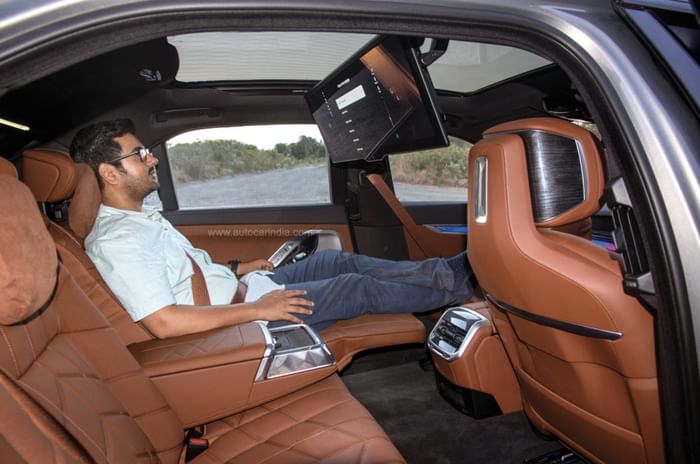
The EQS pampers rear seat occupants to a lesser extent. Yes, it’s got a hint more legroom with the front passenger seat in position and it is comfortable by any measure, but it’s not an S-Class at the rear. Seat adjustment is limited to backrest angle alone, there’s no massage function and the seat itself isn’t generous in thigh support. The EQS’ absence of rear sunblinds and even rear entertainment screens won’t go down well with buyers who spend much of their time at the back.
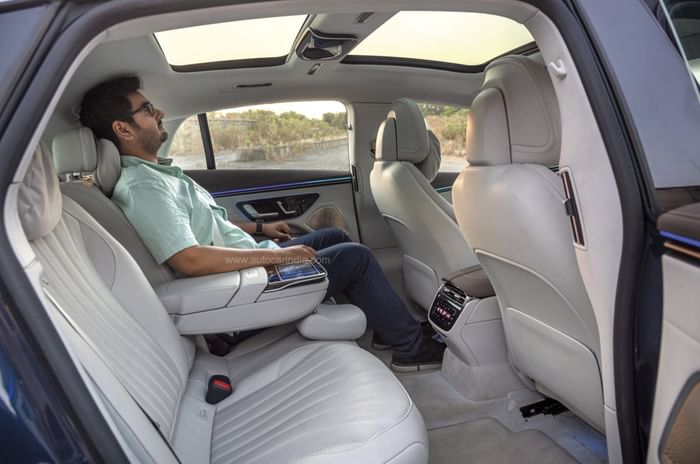 EQS cabin is airy and rear seat is nice enough, but the Merc is down on many frills.
EQS cabin is airy and rear seat is nice enough, but the Merc is down on many frills. BMW i7 vs Mercedes Benz EQS: features
Shifting focus up front, it’s the i7 that has the more conventional dash, though it’s got its share of glitz with a crystal-like band that glows with the ambient lighting. And it doesn’t end there. There are light and sound themes, with the latter composed by Hans Zimmer. It’s all very quirky and cool. Also nicely done are the screens.

The digital dials are very informative and also pack in an augmented reality feature that superimposes navigation arrows on to a camera feed, so you literally cannot take the wrong turn. BMW’s touchscreen is also slick to use, though it packs in way too many functions. More physical shortcuts would help, though it is handy to have the option to use the traditional iDrive rotary controller for inputs.
| Equipment Checklist | ||
|---|---|---|
| BMW i7 xDrive 60 | Mercedes-Benz EQS 580 | |
| Airbags | 8 | 9 |
| ADAS | Yes | Yes |
| Powered doors | Yes | NA |
| Digital dials | 12.3-inch | 12.3-inch |
| Heads-up display | Yes | Yes |
| Touchscreen | 14.9-inch | 17.7-inch (centre) |
| Front seat massage | Yes | Yes |
| Front seat ventilation/heating | Yes/Yes | Yes/Yes |
| Powered rear seat recline | Yes | Yes |
| Extendable rear seat | Yes | NA |
| Rear seat massage | Yes | NA |
| Rear seat ventilation/heating | Yes/Yes | Yes/Yes |
| Rear seat entertainment screen | 31.3-inch | NA |
| Panoramic sunroof | Yes | Yes |
| Rear-axle steering | Yes | Yes |
| Air suspension | Yes | Yes |
It’s a whole different vibe inside the EQS. Think futuristic spacecraft, and you won’t be off. The impression is courtesy of the trio of screens – driver’s display, centre touchscreen and passenger display – that make up Merc’s 56-inch Hyperscreen. It’s big on the wow factor and the vibrant ambient lighting only adds to the effect. Again, the central touchscreen is really responsive, but you’d miss shortcuts for commonly used functions. Of the other things, a large storage in the centre tunnel lends the EQS’ cabin the look of bespoke EVs.
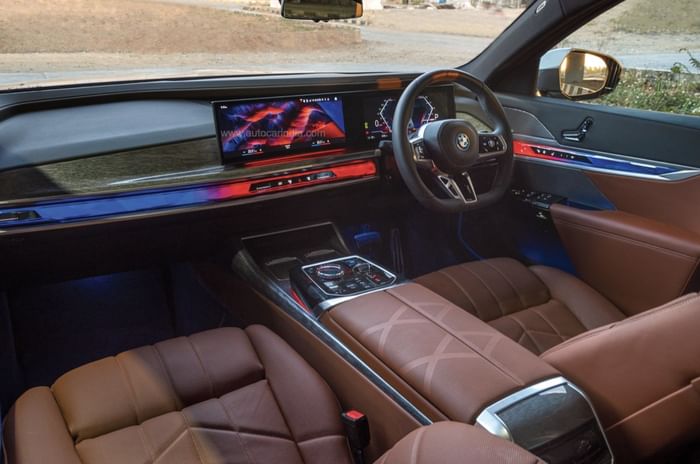
Both sedans score really well on front-seat comfort and, as you’d expect, cabin quality is top-tier stuff.
BMW i7 vs Mercedes Benz EQS: ride and manoeuvrability
Large limousines are at odds with India’s congested roads, so it’s imperative to talk about ease of use before we get into other aspects of their driving experiences. The BMW feels its size around town and can get particularly intimidating at U-turns, even with the helping hand of rear-axle steer that gives 3.5 degrees of lock. Maneuver Assistant, which can memorise the path to a parking slot and complete the job of parking for you does ease life if you are open to the idea, and an i7 raised to full height also clears speedbreakers far more comfortably than the EQS can.
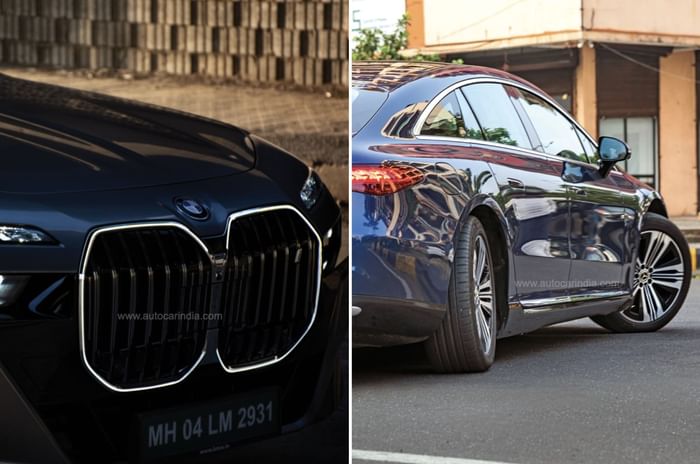
The EQS’ propensity to scrape its belly calls for extra caution. What’s handy is the option to geo-tag a coordinate where the suspension lift function is used. The next time you’re approaching the same spot, you’d get a prompt asking if you’d like to raise the suspension, shortening the process of prepping the car by a step. Otherwise, it’s the Merc that feels lighter on its feet and easier to manoeuvre. The last bit is a function of the rear-axle steer that offers up to 10 degrees of lock. The ‘up to’ is important to put in because you have to take a paid subscription to unlock the full extent of the feature. As standard, the EQS gets 2.5 degrees of rear lock. In low-speed settings, it’s the EQS that has the edge in ride comfort. It’s got the cushier ride and filters out surface imperfections better than the i7 manages to. You’ll also hear a smidgen less of expansion joints in the Merc, though overall refinement levels in both electric sedans are exceptional.
BMW i7 vs Mercedes Benz EQS: performance and handling
Out on the open road, one of these limos feels stately while the other comes across as sporty. And surprise of surprises in a Merc vs BMW competition, it’s the EQS that’s the latter. The Merc’s dual permanently excited synchronous motors produce a combined 523hp and 855Nm, and seemingly give more with less accelerator input. There’s a more sustained push of power that’s really likeable. Around the corners too, the EQS feels like a smaller, tighter car and the slicker steering deepens the impression. The EQS does move about more at higher speeds but nothing a mode change won’t arrest.
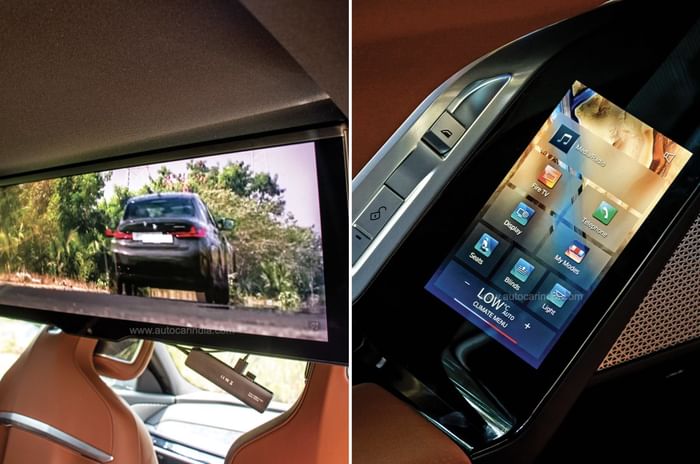
The i7 rides flatter across the suspension settings spectrum, and there’s a reassuring feel at the steering at all times. It’s just that the i7 doesn’t have as much of a playful side as the EQS does. Mind you, there’s no shortage of power or performance. The i7’s pair of electrically excited motors make 544hp and 745Nm, that’s delivered in a smooth wave. For a quick burst of excitement, there’s a Boost button on the steering that has the motors give their all for 10 seconds. The subsequent push back onto your seat is very un-limo-like. In fact, the EQS and i7 with their 4.5-second 0-100kph and sub-10-second 0-160kph times are quick enough to humble many performance-oriented ICE cars. Just don’t expect these EVs’ amplified sound effects to rivet you as an engine’s would.
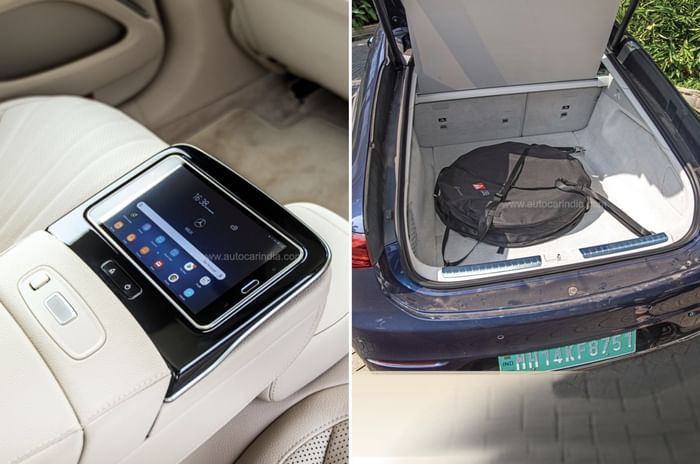
Both models have their quirks in the braking department. The EQS offers easier adjustability of regen levels via the paddleshifters, but its friction brakes need a firmer foot on the pedal than you’d like. On the i7, shuffling between regen modes is a multi-step process via the screen – not ideal.
BMW i7 vs Mercedes Benz EQS: range and charging
So that’s what these two are like to drive and be driven in. But how far can you go with them? It’s the EQS with its bigger 107.8kWh battery that betters the i7 with its 101.7kWh battery pack in this section of the test. In town, the EQS gave a range of 432km to the i7’s 396km. Out on the highway, the Merc will do a real-world 536km to the BMW’s 489km. These are great numbers as EVs go. \
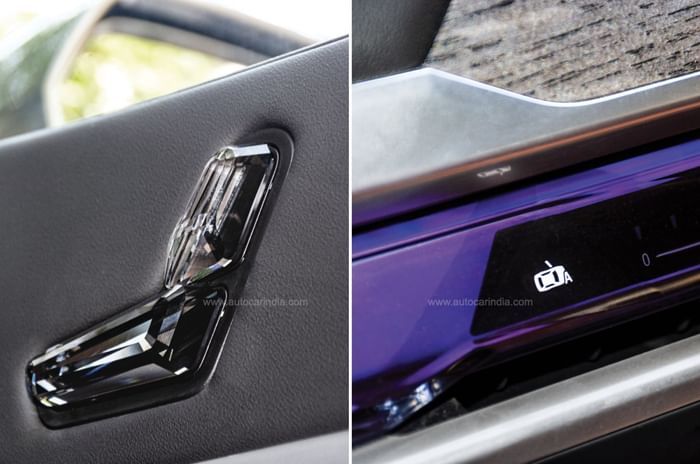
Both models support really fast DC charging (up to 200kW for the EQS and up to 195kW for the i7), though most owners will likely use the public charging network on the rare out-of-town trip. 22kW AC chargers supplied with the cars will be the go to solution for most owners.
On airport runs, it’s the EQS that offers a lot more luggage room, if you remove the spare tyre that is. The BMW’s 500-litre boot is accommodating too and, nope, no spare tyre here. Curiously, neither EV offers a frunk. In fact, the EQS’ bonnet doesn’t open at all.
BMW i7 vs Mercedes Benz EQS: price and verdict
What we’ve learned over our time with the duo is that the i7 and EQS take the story of the luxury limousine forward in different ways. The i7 takes the more traditional route putting the emphasis on the rear seat passenger. Seats extended, backrest reclined... that’s the way you’d want to travel after a tough day at the boardroom. And the very special seating can be enjoyed in silence or with your own theatre on the go.
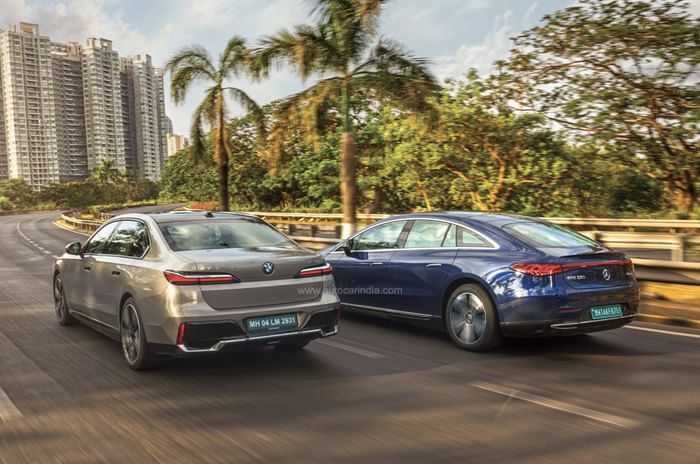
The EQS, on the other hand, is best enjoyed from the driver’s seat. And in that sense appeals to a younger buyer keener on driving than being driven. The Merc feels sportier, and looks it too. And it helps that it’s easier to drive too.
While these are the broader personality traits, the BMW i7 is fun to drive in its own right and the EQS is comfortable as a chauffeur-driven car too. So which is one to buy? For the money-no-object kind of buyer, it’s the better-rounded BMW i7 that you should sign that cheque for. The disclaimer is important because the fully imported i7 comes in at Rs 1.95 crore.
That’s a full Rs 36 lakh more than what the locally assembled EQS 580 will set you back by. But see what you get for what you pay, and it’s the EQS that whooshes ahead.
| Figures | ||
|---|---|---|
| BMW i7 xDrive 60 | Mercedes-Benz EQS 580 | |
| Verdict | Feels like the electric 7 series that it is. Rear seat comfort is the big pull here, but it is expensive. | It's not your typical Merc limo, and puts the onus on the experience up front. Well-rounded and well-priced. |
| L/W/H | 5391/1950/1544mm | 5261/1926/1512mm |
| Wheelbase | 3215mm | 3210mm |
| Ground clearance | 136mm | 134mm |
| Motor | Dual electrically excited synchronous | Dual permanently excited synchronous |
| Power | 544hp | 523hp |
| Torque | 745Nm | 855Nm |
| Gearbox | 1-speed auto | 1-speed auto |
| Kerb weight | 2640kg | 2585kg |
| Boot capacity | 500 litres | 610 litres |
| Acceleration from rest | ||
| 20kph | 0.79sec | 1.08sec |
| 40kph | 1.66sec | 2.11sec |
| 60kph | 2.53sec | 2.74sec |
| 80kph | 3.44sec | 3.49sec |
| 100kph | 4.57sec | 4.47sec |
| 120kph | 5.97sec | 5.69sec |
| 140kph | 7.67sec | 7.41sec |
| 160kph | 9.69sec | 9.59sec |
| Rolling acceleration | ||
| 20-80kph | 2.65sec | 2.37sec |
| 40-100kph | 2.89sec | 2.77sec |
| Battery and range | ||
| Battery Capacity | 101.7kWh | 107.8kWh |
| Battery type | Lithium-ion | Lithium-ion |
| Range (WLTP) | 591-625km | 677km |
| Range (ARAI) | NA | 857km |
| Range as tested (city/highway) | 396/489km | 432/536km |
| Charging time | ||
| DC (10-80%) | 34min (195kW DC) | 31min (200kW DC) |
| 22kW AC (0-100%) | 5hrs | 5hrs 15min |
| 11kW AC (0-100%) | 10hrs 30min | 11hrs |
| Price | ||
| Ex-showroom, India | Rs 1.95 crore | Rs 1.59 crore |





























